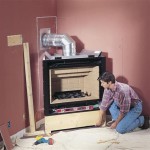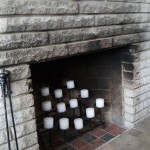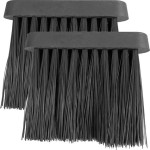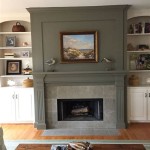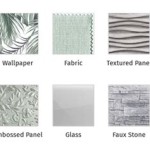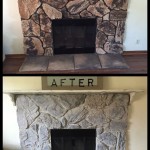How To Spray Paint A Fireplace Insert: A Comprehensive Guide
Spray painting a fireplace insert is a cost-effective method to refresh its appearance and extend its lifespan. Over time, fireplace inserts can become discolored, rusty, or simply outdated. Instead of investing in a new insert, a fresh coat of high-temperature paint can revitalize the unit, making it look new while also providing a protective layer against further wear and tear. This process, while seemingly straightforward, requires careful planning, preparation, and execution to achieve a durable and aesthetically pleasing result. This article provides a detailed, step-by-step guide outlining the process of spray painting a fireplace insert, ensuring a successful outcome. This includes surface preparation, paint selection, application techniques, and safety precautions. Adhering to these guidelines ensures a professionally finished appearance and maximizes the longevity of the paint job.
Key Point 1: Essential Preparation for a Successful Outcome
Proper preparation is the foundation for a successful spray painting project. Neglecting this step can lead to poor paint adhesion, uneven coverage, and a finish that deteriorates quickly. The preparation process involves several crucial stages, including removing the insert (if possible), cleaning the surface thoroughly, masking off surrounding areas, and sanding to create a suitable texture for paint adhesion. Each of these elements contributes to a durable and aesthetically pleasing result.
Firstly, the fireplace insert should be removed from the fireplace opening, if feasible. This allows for easier access to all surfaces and minimizes the risk of overspray onto surrounding areas. If removal is impossible, consider applying extensive masking to adequately protect the surrounding brickwork, mantel, and flooring. Use painter's tape and plastic sheeting to create a barrier that prevents paint from reaching unintended surfaces. Applying multiple layers of masking can provide additional protection, especially in areas that are difficult to cover completely.
Cleaning the fireplace insert is paramount to remove soot, dust, rust, and any other contaminants that could interfere with paint adhesion. Use a wire brush to remove loose rust and flaking paint. For heavily rusted areas, consider using a rust converter product before proceeding. Subsequently, use a degreaser or TSP (trisodium phosphate) solution mixed with water to thoroughly scrub the surface. This removes any grease or oils that may be present, ensuring a clean surface for the paint to adhere to. Rinse the insert thoroughly with clean water and allow it to dry completely. Ensure the insert is completely dry before proceeding to the next step.
Sanding the surface of the fireplace insert is essential to create a texture that allows the paint to grip properly. Use sandpaper with a medium grit (around 120-180 grit) to lightly scuff the entire surface. This creates microscopic grooves that enhance paint adhesion. For smoother surfaces, consider using a higher grit sandpaper (around 220 grit). After sanding, wipe down the surface with a tack cloth to remove any remaining dust particles. This ensures a clean and smooth surface for optimal paint application.
Key Point 2: Selecting the Right Paint and Applying it Correctly
Choosing the correct type of paint is crucial for the longevity and performance of the finished product. Given the high temperatures that fireplace inserts endure, it is imperative to use a high-heat resistant paint specifically designed for this purpose. Ordinary paints will blister, crack, and peel under high temperatures, leading to an unsatisfactory and potentially unsafe outcome. Furthermore, applying the paint in thin, even coats is critical to prevent runs, drips, and uneven coverage. Proper application techniques ensure a smooth, professional finish that withstands the heat and provides long-lasting protection.
Specifically, high-heat spray paints formulated for stoves, grills, and engine components are ideal. These paints are typically rated to withstand temperatures ranging from 1200°F to 2000°F. Read the product label carefully to ensure it is suitable for the maximum temperature your fireplace insert is likely to reach. Choose a color and finish that complements the surrounding décor. Matte black is a common choice for fireplace inserts, as it provides a classic and understated look. However, other colors and finishes are available to suit individual preferences. Consider a satin or semi-gloss finish for added durability and ease of cleaning.
Before applying the paint, shake the can vigorously for at least two minutes to ensure the paint is thoroughly mixed. Hold the can approximately 10-12 inches away from the surface and apply a thin, even coat using a side-to-side motion. Avoid holding the can in one spot for too long, as this can lead to runs and drips. Overlapping each pass slightly ensures complete coverage. Allow the first coat to dry completely, as per the manufacturer's instructions, usually around 30 minutes to an hour. Inspect the surface for any imperfections or areas that require additional coverage. Apply a second thin coat using the same technique. Multiple thin coats are always preferable to a single thick coat, as they result in a smoother, more durable finish. For optimal results, consider applying a third thin coat.
To avoid overspray onto surrounding areas, maintain a consistent distance and angle while spraying. This helps to control the amount of paint being applied and minimizes the risk of paint drifting onto unintended surfaces. Work in a well-ventilated area or outdoors to avoid inhaling the fumes. Wear a respirator or mask to protect your lungs from harmful vapors. After applying all coats, allow the paint to dry completely for at least 24 hours, or longer if recommended by the manufacturer. This allows the paint to fully cure and harden, ensuring maximum durability and heat resistance.
Key Point 3: Safety Precautions and Post-Painting Procedures
Safety should be the primary concern throughout the entire spray painting process. High-heat paints often contain volatile organic compounds (VOCs) that can be harmful if inhaled. Additionally, the flammability of spray paints presents a fire hazard. Taking appropriate safety precautions, such as working in a well-ventilated area, wearing protective gear, and storing paint properly, is essential to prevent accidents and protect one's health. Following the painting process, proper curing and reinstallation of the insert are crucial for optimal performance and longevity.
Working in a well-ventilated area is critical to minimize exposure to harmful fumes. If possible, perform the spray painting outdoors. If working indoors, open windows and doors to provide adequate ventilation. Use fans to circulate air and remove fumes from the work area. Wear a respirator or mask specifically designed to filter out paint fumes. This protects your lungs from harmful chemicals and prevents respiratory irritation. Wear gloves to protect your hands from paint and chemicals. Eye protection, such as safety glasses or goggles, is also recommended to prevent paint from splashing into your eyes.
Store spray paint cans in a cool, dry place away from heat sources and open flames. Keep the cans out of reach of children and pets. Dispose of empty paint cans properly, following local regulations for hazardous waste disposal. Never puncture or incinerate spray paint cans, as this can cause them to explode. Clean up any spills immediately with a suitable solvent. Dispose of used rags and cleaning materials properly, as they may be flammable.
After allowing the paint to dry completely as per the manufacturer's instructions, the fireplace insert needs to be cured. Curing involves gradually heating the insert to allow the paint to fully harden and bond to the surface. Begin by placing the insert back into the fireplace opening (if it was removed). Start a small fire or use a heat source to gradually warm the insert. Increase the heat gradually over several hours, allowing the paint to cure without blistering or cracking. Monitor the insert closely during the curing process. If any signs of blistering or cracking appear, reduce the heat immediately. Allow the insert to cool completely before using the fireplace regularly. This curing process helps to ensure the paint's long-term durability and heat resistance. With proper preparation, application, and curing, the spray-painted fireplace insert will provide years of renewed beauty and functionality.

How To Spray Paint A Brass Fireplace Insert Erfly House

How To Spray Paint A Brass Fireplace Insert Erfly House

How To Spray Paint A Brass Fireplace Insert Erfly House

How To Spray Paint A Brass Fireplace Insert Erfly House

How To Spray Paint The Fireplace Surround My Homier Home

How To Spray Paint A Brass Fireplace Insert Erfly House

How To Update Brass Fireplace Insert With Spray Paint Iekel Road Home

Fireplace Makeover Spray Paint Magic

How To Spray Paint A Brass Fireplace Bright Green Door

How To Spray Paint Fireplace Interior The Diy Playbook
Related Posts

